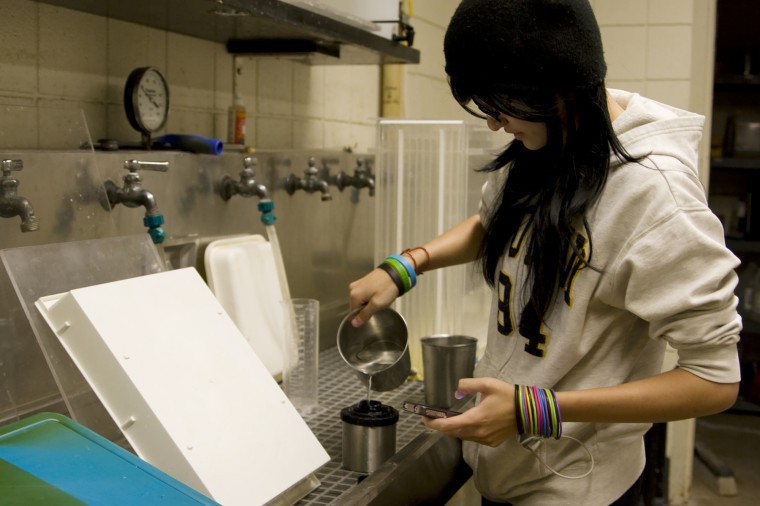Cost of art supplies burdens student wallets
Brittany Carr, senior photo major, prepares film for development in the Jack Arends Art Building Monday evening.
April 9, 2012
There’s no painting without pain. That is, pain to the wallet.
Aside from tuition, art students at NIU have another financial aspect to worry about: art supplies.
While some supplies may come cheap, such as paper and some drawing utensils, others, such as film, metals and paint, do not.
Graduate photography major Emily Franklin said paying for paper, camera equipment and props are not the problem.
“Mostly it’s memory cards and film that are the big things,” she said. “It’s an inevitability of being an art student.”
Franklin said every month, she spends about $250 on supplies, around $1,000 each semester.
“It’s a bummer and definitely a burden, but I’m used to it,” she said.
Lee Sido, associate professor of art, said the costs students will have to pay depends on both what they’re studying as well as their individual classes.
“Depending on the course fees for that area, it might just cover certain expendible materials,” he said. “For example, in sculpture, we have the the blades for the power machines. We try to supply most of the tools and expendable materials because it’s easier for us to buy and bring in. Certainly not a lot of students can fit a 4-by-8 sheet of plywood into their vehicles.”
Sido also said he normally picks up some of the supplies himself, depending on the pickup location.
In order to pay for supplies, some art students turn to loans, credit cards or scholarships. Franklin said she teaches a photo class and does freelance work outside of school in order to cover the costs.
“I try for scholarships as well, but you don’t always win,” she said. “Now, I’m desperately seeking a summer job just to get some income.”
Similarly, junior metals major Kylie Baker said she expected to pay for her own supplies, like silver and copper.
Despite the cash art students drop for their supplies, neither Baker nor Franklin are upset about what they have to pay.
“I don’t expect the university to have to pay for our metals,” Baker said. “But for the stuff we practice or sample on, I do appreciate the university paying for that. Although it’s expensive, it’s reasonable.”
Sido said art students having to pay for some of their own art supplies while still in school is an example of the reality they might have to deal with if they continue to pursue art as a career.
“The reality is a tremendous burden on artists,” he said. “Often, people don’t think about the costs in reference to the artists.”
Other students, such as senior art major Ekaterina Gurka, also has a part time job and pays for supplies out of pocket.
For drawing foundations classes, she said, students have to buy an art kit that costs almost $120 at the VCB.
“I had to buy two kits, but it’s covered by my financial aid,” Gurka said. “That way I don’t need to look for every individual piece. I also had to spend money on other minor things during the semester.”
One way some students cut costs when buying supplies is buying in bulk. Junior metals major Megan Degen said she and her friends will buy supplies in big numbers and split the costs for each person.
“If we’re in a group, we figure how much each person needs and we buy it in bulk and split the cost,” Degen said. “So, we can get them for a discounted price.”
While she agrees with Baker and Franklin about the university paying for certain supplies and not others, Gurka said it would be easier to know what they need to spend ahead of time.
“If they don’t cover the costs, the university should at least give us a range for each student before telling us to pay for it on our own,” Gurka said.
Sido said sometimes, the materials art students are required to pay for take the place of textbooks.
“They may not have the burden of expensive textbooks for a studio class,” he said. “A typical college student might be dropping $500 to $600 on books. That’s our theoretical equivalent.”







